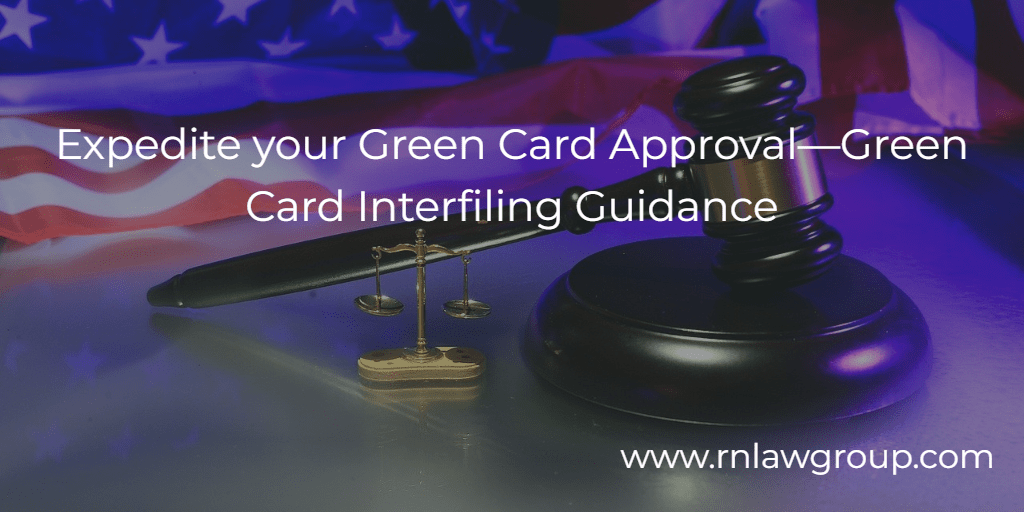
Expedite your Green Card Approval—Green Card Interfiling Guidance
The Green Card (Lawful Permanent Resident) process can be complex and time consuming. We know individuals and families can wait years if not decades (!) for approval of their Green Card. Due to certain immigration law mechanisms, there exists long backlogs for certain Green Card types and these backlogs can be exacerbated based on an individual’s country of birth.
There are a number of tactics and strategies than can be effectively leveraged to expedite the Green Card approval process. One such tactic is known as “interfiling” or a “transfer of underlying basis”. In the past, this was a theoretical approach which we saw as successful. To close the gaps and provide solid roadmaps for immigrants and practitioners, USCIS has issued formal guidance regarding “Transfers of Underlying Basis”, more commonly known as Green Card interfilings. A “Transfer of Underlying Basis” or “interfiling” is based on a pending I-485 Green Card petition. For purposes of our discussion a “Transfer of Underlying Basis” is a request to transfer your employment-based green card from one employment-based immigrant category to another, different employment-based immigrant category while remaining with the same company (“employment-based sponsor”).
For example, suppose you have two approved I-140s (one EB-2 and one EB-3) from Company A. Your priority date was current under EB-3, so you filed your Green Card based on that EB-3 I-140 approval. Now, you’ve noticed that EB-2 dates are more advantageous than EB-3. You can request USCIS to transfer the underlying basis of your pending I-485 from its originally filed EB-3 category to the “more preferred” EB-2 category. By using the “Transfer of Underlying Basis” interfiling mechanism, USCIS will consider your I-485 under the EB-2 preference category instead of the originally filed EB-3 preference category.
To qualify for a “Transfer of Underlying Basis,” you must:
- Continually maintain eligibility for the underlying/original classification requested.
- Keep your I-485 pending.
- Be eligible for the substituted classification requested.
- Have a current priority date under the substituted classification requested.
As a reminder. USCIS does not charge a fee for this request,Top of Form
Continuously maintaining eligibility for the underlying/original classification requested doesn’t necessarily require maintaining non-immigrant status or holding a non-immigrant visa to utilize a transfer of underlying basis. Rather, the focus should be on the status of the underlying/supporting I-140 itself—has it been withdrawn or revoked? Have you attempted an I-485 Supplement J portability of the job offer to another employer? If so, it’s likely that you haven’t maintained eligibility for the underlying/original classification requested. Essentially, if the I-140 supporting the original filing of your I-485 remains valid, you shouldn’t have concerns about maintaining eligibility for the underlying/original classification requested.
Being eligible for the substituted classification requested is typically a simple procedural matter. In the scenario mentioned above, where EB-2 and EB-3 I-140s are already approved through Company A, having these approvals in hand typically implies eligibility for the substituted classification requested.
Let’s say you only have an I-140 approval in EB-2. Can you obtain an approval in EB-3? Almost always, the answer is yes. Please view our article on I-140 Downgrades here. Many EB-2 applicants are eligible to “downgrade” to EB-3 to expedite their I-485 application. This downgrade can be achieved by refiling a previously approved EB-2 I-140 in the EB-3 category or by filing an EB-2 intended Labor Certification in the EB-3 category. Additionally, individuals with approved EB-2 petitions can downgrade to EB-3 using the same Labor Certification, provided it was filed during the Labor Certification’s original six-month validity period. Similarly, those with pending or approved EB-2 Labor Certifications can use the Labor Certification to file EB-3 cases. Premium Processing availability depends on whether the case is filed with an original Labor Certification or a copy of an expired one. Timing for downgrading is crucial, especially considering potential advancements in Visa Bulletin cutoff dates, particularly for EB-2 and EB-3 India categories. For personalized advice, individuals are encouraged to consult qualified attorneys.
Interfiling requests are generally straightforward. However, a major concern with requesting an interfiling is that USCIS doesn’t provide receipts for such requests. In their new guidance, USCIS implicitly suggests that filing an I-485J from the sponsoring company to confirm the job offer is the only available means to obtain any documentation from USCIS indicating that an interfiling request has been made and/or accepted.
For example, if I have a pending EB-3 I-485 along with an approved EB-2, both sponsored by the same company, I can request an interfiling from USCIS by sending a letter via mail. However, USCIS doesn’t provide a receipt notice for this request. Instead, I can simultaneously request an interfiling from USCIS while submitting an I-485J from the company to confirm the ongoing availability of the EB-2 job offer. USCIS will issue a receipt notice for the I-485J. Therefore, if one intends to request a Transfer of Underlying Basis, it’s advisable to do so concurrently with filing an I-485 Supplement J from the I-140 sponsoring company.
It’s important to note that a request for Transfer of Underlying Basis is not guaranteed. USCIS will review the request at their discretion. If the request is denied, there are no adverse consequences to the pending Green Card application; it simply remains pending under its originally filed employment-based classification. While USCIS seems receptive to transfers between the first three employment-based categories, the approval of the Transfer of Underlying Basis ultimately lies with USCIS, and there is generally no option to appeal this decision. In addition to the eligibility criteria mentioned earlier, USCIS will consider factors such as the additional processing time required to gather evidence for the new claim, the reasons behind the request, the availability of supporting documentation, the difficulty in obtaining necessary files from other USCIS offices, the assessment of continued eligibility from the original petition, and the progress already made on the adjustment application.
By: Ryan A. Wilck, Partner and Attorney at Law
Ryan Wilck is an Attorney at Reddy & Neumann P.C. helping clients with the final phases of the permanent residence process. “Concilio et labore” is not only the motto of Ryan’s favorite sports club but is also his life motto; all things come through wisdom and effort. Ryan is passionate about gaining the trust of his clients by utilizing a relentless and detail-oriented work ethic to understand their specific goals and concerns, hoping to instill a sense of confidence and stability. Whatever your immigration problem, he and his team will find a solution, through wisdom and effort.

